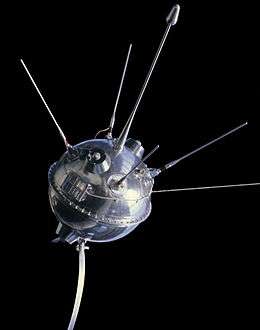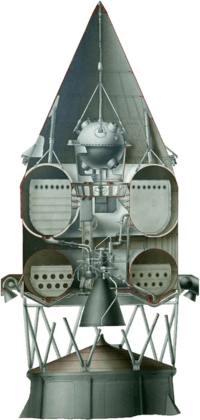Luna 1
Luna 1, also known as Mechta (Russian: Мечта [mʲɪt͡ɕˈta], lit.: Dream), E-1 No.4 and First Lunar Rover,[5] was the first spacecraft to reach the vicinity of the Earth's Moon, and the first spacecraft to be placed in heliocentric orbit. Intended as an impactor, Luna 1 was launched as part of the Soviet Luna programme in 1959, however due to an incorrectly timed upper stage burn during its launch, it missed the Moon, in the process becoming the first spacecraft to leave geocentric orbit.
 A museum replica | |
| Mission type | Lunar impactor[1] |
|---|---|
| Operator | Soviet Union |
| Harvard designation | 1959 Mu 1[2] |
| COSPAR ID | 1959-012A[3] |
| SATCAT no. | 00112[3] |
| Mission duration | Approximately 62 hours[1] |
| Orbits completed | 43 of sun (as of 2012) |
| Spacecraft properties | |
| Spacecraft type | Ye-1 |
| Manufacturer | OKB-1 |
| Launch mass | 361.3 kilograms (797 lb) |
| Start of mission | |
| Launch date | 2 January 1959, 16:41:21 GMT |
| Rocket | Luna 8K72 |
| Launch site | Baikonur, Site 1/5 |
| End of mission | |
| Last contact | 5 January 1959 |
| Orbital parameters | |
| Reference system | Heliocentric |
| Semi-major axis | 1.146 AU |
| Eccentricity | 0.14767 |
| Perihelion altitude | 0.9766 AU |
| Aphelion altitude | 1.315 AU |
| Inclination | 0.01° |
| Period | 450 days |
| Epoch | 1 January 1959, 19:00:00 GMT[4] |
| Lunar flyby (failed impact) | |
| Closest approach | 4 January 1959 |
| Distance | 5,995 kilometres (3,725 mi) |
A malfunction in the ground-based control system caused an error in the rocket's burntime, and the spacecraft missed the target and flew by the Moon at a distance of 5900 km (more than three times the Moon's radius) at the closest point. Luna 1 then became the first human-made object to reach heliocentric orbit and was then dubbed "Artificial Planet 1"[6] and renamed Mechta (Dream).[7] Luna 1 was also referred to as the "First Cosmic Ship",[6] in reference to its achievement of Earth escape velocity.
Background
Luna 1 was the fourth and final spacecraft of the Ye-1 spacecraft series. The previous three iterations did not achieve orbit due to issues with each rocket launch.[2]
Spacecraft
The satellite and rocket carrying Luna 1 was originally referred to as the Soviet Space Rocket by the Soviet Press.[1] Pravda writer Alexander Kazantsev called it Mechta (Russian: Мечта, meaning 'dream').[8][9] Citizens of Moscow unofficially deemed it Lunik, a combination of Luna (Moon) and Sputnik.[8] It was renamed to Luna 1 in 1963.[2][1]
The spherical satellite was powered by mercury-oxide batteries and silver-zinc accumulators.[3] There were five antenna on one hemisphere, four whip-style and one rigid, for communication purposes. The spacecraft also contained radio equipment including a tracking transmitter and telemetry system.[2] There was no propulsion system.[3]
Luna 1 was designed to impact the Moon, delivering two metallic pennants with the Soviet coat of arms that were included into its payload package.[2] It also had six instruments to study the Moon and interplanetary space. The flux-gate magnetometer was triaxial and could measure ± 3000 gammas. It was designed to detect lunar magnetic fields.[10] Two micrometeorite detectors, developed by Tatiana Nazarova of the Vernadsky Institute, were installed on the spacecraft. They each consisted of a metal plate with springs and could detect small impacts.[10] Four ion traps, used to measure solar wind and plasma, were included. They were developed by Konstantin Gringauz.[10] The scientific payload also included two gas-discharge Geiger counters, a sodium-iodide scintillation counter, and a Cherenkov detector. The upper stage of the rocket contained a scintillation counter and 1 kilogram (2.2 lb) of sodium for a gas-dispersion experiment.[3][1]
The spacecraft weighed 361.3 kilograms (797 lb) at launch.[1]
Launch
Luna 1 was launched at 16:41 GMT (22:41 local time) on 2 January 1959 from Site 1/5 at the Baikonur Cosmodrome by a Luna 8K72 rocket.[1] The first three stages operated nominally. The Soviet engineers did not trust automated systems for controlling the engine burns, so they communicated to the rocket via radio. The signal to stop firing the engine Block E stage was sent too late,[11] and it imparted an extra 175 m/s to Luna 1.[1] Consequently Luna 1 missed its target by 5,995 kilometers (3,725 mi).[2] The spacecraft passed within 5,995–6,400 kilometers (3,725–3,977 mi) of the Moon's surface on 4 January after 34 hours of flight.[3][1] Luna 1 ran out of battery power on 5 January 1959 when it was 597,000 kilometers (371,000 mi) from Earth, making it impossible to track further.[1][12] The batteries were designed for a minimum of 40 hours but lasted for 62.[12]
Luna 1 became the first artificial object to reach the escape velocity of the Earth,[13] along with its carrier rocket's 1,472-kilogram (3,245 lb)[3] upper stage, which it separated from after being the first spacecraft to reach heliocentric orbit.[1] It remains in orbit around the Sun, between the orbits of Earth and Mars.[3]
Experiment results
At 00:57 GMT on 3 January 1959, at a distance of 113,000 kilometres (70,000 mi) from Earth,[1] 1 kilogram (2.2 lb) of sodium gas was released by the spacecraft, forming a cloud behind it to serve as an artificial comet. The cloud was released for two purposes: to allow visual tracking of the spacecraft's trajectory[14] and to observe the behavior of gas in space.[3] This glowing orange trail of gas, visible over the Indian Ocean with the brightness of a sixth-magnitude star for a few minutes, was photographed by Mstislav Gnevyshev at the Mountain Station of the Main Astronomical Observatory of the Academy of Sciences of the USSR near Kislovodsk.[15] It served as an experiment on the behavior of gas in outer space.
While traveling through the outer Van Allen radiation belt, the spacecraft's scintillator made observations indicating that a small number of high-energy particles exist in the outer belt. The measurements obtained during this mission provided new data on the Earth's radiation belt and outer space. The craft was unable to detect a lunar magnetic field which placed an upper limit on its strength of 1/10,000th of Earth's.[3][16] The first-ever direct observations and measurements of solar wind,[5][3] a strong flow of ionized plasma emanating from the Sun and streaming through interplanetary space, were performed.[3] That ionized plasma concentration was measured to be some 700 particles per cm3 at altitudes of 20,000–25,000 km and 300 to 400 particles per cm3 at altitudes of 100,000–150,000 km.[15] The spacecraft also marked the first instance of radio communication at the half-million-kilometer distance.
Reaction
Some doubted the veracity of the Soviets' claim of mission success. Lloyd Malan wrote about it in a book called The Big Red Lie. Many in the West did not receive transmissions from the spacecraft even though the Soviets publicized them before the flight. By the time the Earth rotated so that scientists in America could pick up signals from the spacecraft, it was already 171,000 kilometers (106,000 mi) away.[17]
The Soviet Union issued stamps to commemorate their success.[18]
Subsequent missions

Luna 2, the second spacecraft of the Ye-1A series, successfully completed the mission on 13 September 1959.[19][20]
References
- Siddiqi 2018, p. 11.
- "Luna Ye-1". Gunter's Space Page. Retrieved 9 November 2019.
- "Luna 1". NASA Space Science Data Coordinated Archive.
- "Luna 1 Launch and Trajectory Information". NASA Space Science Data Coordinated Archive. Retrieved 2 May 2018.
- Harvey 2007a, p. 26.
- https://nssdc.gsfc.nasa.gov/nmc/spacecraft/display.action?id=1959-012A - 27 February 2020
- Cormack 2012, p. 342.
- "New Soviet Rocket Given Name 'Mechta'". The Plain Speaker. Associated Press. 5 January 1959. p. 1 – via Newspapers.com.
- Darling 2003, p. 244.
- Harvey 2007b, p. 26.
- Reichl 2019, p. 20.
- Reichl 2019, p. 21.
- Siddiqi 2018, p. 1.
- Carey, Frank E. (3 January 1959). "Soviet Moon Rocket Releases Sodium Cloud as 'Tail Light'". St. Louis Post Dispatch. St. Louis, Missouri. Associated Press. p. 2 – via Newspapers.com.
- "Soviet Space Rocket". Yearbook of the Great Soviet Encyclopedia (in Russian). Moscow: Sovetskaya Enciklopediya. 1959. ISSN 0523-9613. Archived from the original on 18 January 2008.
- Huntress Jr, Wesley T.; Marov, Mikhail Ya (2011). Soviet Robots in the Solar System Mission Technologies and Discoveries. Springer-Praxis. p. 235. ISBN 978-1-4419-7897-4.
- Harvey 2007b, pp. 28–29.
- Harvey 2007b, p. 30.
- "Luna Ye-1A". Gunter's Space Page. Retrieved 9 November 2019.
- "Chronology – Five key dates in the race to the moon". Reuters. 21 October 2008. Retrieved 10 November 2019.
External links
- Cormack, Lesley B. (2012). A History of Science in Society: From Philosophy to Utility (2nd ed.). University of Toronto Press. ISBN 978-1-4426-0446-9.CS1 maint: ref=harv (link)
- Darling, David (2003). The complete book of spaceflight: from Apollo 1 to zero gravity. John Wiley and Sons. ISBN 978-0-471-05649-2.CS1 maint: ref=harv (link)
- Harvey, Brian (2007a). Russian planetary exploration: history, development, legacy, prospects. Springer. ISBN 978-0-387-46343-8.CS1 maint: ref=harv (link)
- Harvey, Brian (2007b). Soviet and Russian Lunar Exploration. Chichester, UK: Springer. ISBN 978-0-387-21896-0. LCCN 2006935327.CS1 maint: ref=harv (link)
- Reichl, Eugen (2019). The Soviet Space Program: the Lunar Mission Years 1959–1976. Translated by David Johnston. Atglen, Pennsylvania: Schiffer Publishing. ISBN 978-0-7643-5675-9. LCCN 2017955750.CS1 maint: ref=harv (link)
- Siddiqi, Asif A. (2018). Beyond Earth: A Chronicle of Deep Space Exploration, 1958–2016 (PDF). The NASA history series (second ed.). Washington, D.C.: NASA History Program Office. ISBN 978-1-62683-042-4. LCCN 2017059404. SP2018-4041.CS1 maint: ref=harv (link)
| Wikimedia Commons has media related to Commons:RIA Novosti/Luna 1. |
- Boris Chertok, "Rakety i liudi: goriachie dni, kholodnoy voyny", Moscow, "Mashinostroenie", 2nd edition (1999). Sect. 2–7.
- Zarya – Luna 1 chronology